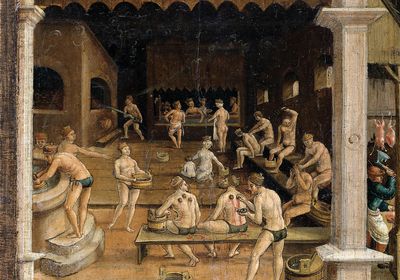ABOVE: GERMANISCHES NATIONALMUSEUM, NUREMBERG
In medieval times, long before there were bathrooms in private homes, bathing was a social affair. Visitors to Dutch and German bathhouses in the late Middle Ages emerged from such spaces cleansed of more than just their grime: They also received basic medical care from “baders,” bathhouse proprietors who were also licensed health practitioners, skilled at lancing abscesses and pulling teeth. Steam rooms, mineral baths, cupping, and herbal concoctions were also commonly used to alleviate ailments from scabies and leprosy to migraines and miscarriages.
Not until Victorian times would bathhouses become a little noticed but influential item in public health policies. But according to Janna Coomans, a historian at Utrecht University in the Netherlands who studies public health in medieval cities, bathhouses provided access to more affordable medical care as baders charged less than doctors for their services. Sweating, bloodletting, and lancing were attempts to correct an imbalance in the four “humors”—phlegm, blood, yellow bile and black bile—that were thought to cause ill health. While these practices may seem unhygienic by modern standards, bathhouses enabled “a large part of the population to maintain health and hygienic norms, according to their ideas of health,” Coomans says.
Historical records show that baders held a stained reputation, however. Even though many were trained in and approved by guilds, surgeons scorned them as incompetent, akin to quacks and travelling shamans, Coomans says. “There was a strong wish [among the medical elite] to control who gets to practice medical procedures,” she says.
Despite these professional squabbles, bathhouses still held a strong social place in communities, and their popularity throughout the 14th and 15th centuries helped shape the public health services of larger cities as they grew and health conditions deteriorated. As Coomans and fellow historian Guy Geltner argue in their treatise on medieval urban hygiene, local authorities sought to promote health and curb disease, devising policies that they likely gleaned from medical practitioners and popular attitudes toward hygiene. Dismissing the role of bathhouses in early attempts to design healthier cities and rid city streets of foul stenches therefore “obscures their immense contribution,” Coomans and Geltner write, as bathhouses likely served as a “vector transporting medical theory into urban policy.”
Their popularity over the next few centuries tracked advances in medicine and public health. By the 16th century, urban bathhouses started to disappear as Europe was ravaged by plague, smallpox, and syphilis, and as theories of contagion became more widely discussed in medical circles. People were advised to avoid public baths, along with other crowded places, although it would take another three centuries before Louis Pasteur and Robert Koch solidified the germ theory of disease in the 1880s.
By then, public baths had seen another change in fortune, with the emergence of free-to-use facilities in Britain. Sanitation reformers argued that making bathing facilities available to the poorest classes of society offered an “affordable and immediate way” of improving public cleanliness and health, University of Liverpool historian Sally Sheard writes. Yet as Sheard notes, many historians have since overlooked the provision of public baths, focusing instead on the installation of waterworks and sewage systems that together laid the foundations for the UK Public Health Act, which passed in 1848.




